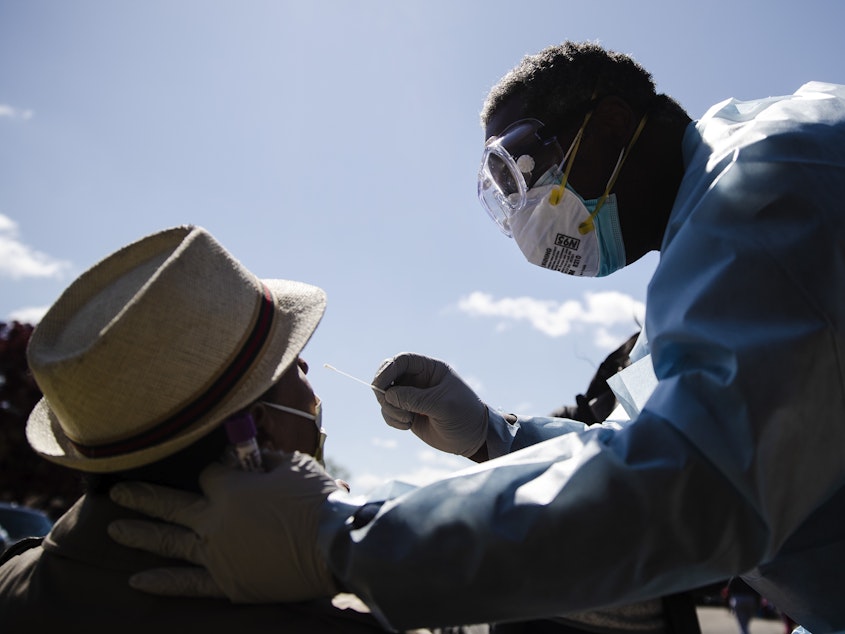'Racial Inequality May Be As Deadly As COVID-19,' Analysis Finds

Even during the COVID-19 pandemic, mortality rates and life expectancy are far better for white Americans than they are for Black people during normal, non-pandemic years, according to an analysis published this week in the Proceedings of the National Academy of Sciences.
The analysis, which looked at U.S. mortality statistics back to 1900, finds an additional 1 million white Americans would have to die this year in order for their life expectancy to fall to the best-ever levels recorded for Black Americans — back in 2014. That year, the average life expectancy for African Americans was 75.3 years — similar to the average life expectancy for white Americans back in 1989, says study author Elizabeth Wrigley-Field.
"It's as though Blacks have just missed out on the last three decades of [life expectancy] progress," says Wrigley-Field, a demographer and infectious disease historian at the Minnesota Population Center at the University of Minnesota.
The findings underscore the pandemic scale of the racial inequalities in mortality in the U.S., she says.
"We don't know what the ultimate scale of COVID-19 deaths is going to be," Wrigley-Field says. "But what we can say is that white deaths to COVID would have to increase from what they are right now by a factor of [more than] five to make white death rates this year look like the best that Black death rates have ever been."
She notes that 2014 was also the year when Black Americans had their lowest age-adjusted death rates on record — 1,061 deaths per 100,000. By comparison, for whites, the age-adjusted mortality rate was 899 per 100,000 in 2017 (the last year with available data). To match the lowest mortality rates on record for Black Americans, more than an additional 400,000 white Americans would have to die this year, her analysis found.
Thus far, COVID-19 has taken a disproportionate toll on Black people and other communities of color. Black Americans have experienced the highest death rates from the pandemic — about 88.4 deaths per 100,000, compared to 40.4 per 100,000 for white Americans, according to data compiled by the APM Research Lab.
As the Centers for Disease Control and Prevention noted in a report last week, there are multiple factors behind these pandemic disparities, including the facts that Black Americans and other people of color are disproportionately represented among essential workers who cannot perform their jobs while sheltering at home, and they're more likely to live in multigenerational households and crowded housing conditions that can increase the risk of exposure to the coronavirus.
But there are also longstanding systemic reasons behind these racial health disparities, notes Dr. Utibe Essien, a health equity researcher with the University of Pittsburgh — factors that include Black Americans' well-documented disparities in access to quality health care.
African Americans have higher rates of underlying medical conditions, including diabetes, heart disease and lung disease, that are linked to more severe cases of COVID-19. Black people in the U.S. also bear the burden of historic discrimination policies, Essien says, such as redlining policies in housing that limited African Americans' ability to accumulate wealth through property ownership. And wealth is a significant driver of health, Essien notes.
"I think it's important to ... appreciate that the pandemic didn't start something new, but that these disparities really, unfortunately, have been seen for decades, if not centuries," he says.
Indeed, Wrigley-Field says she was inspired to carry out the current analysis after conducting an earlier study on regional mortality rates from infectious disease during the early 20th century. "The thing that we found that stunned us was that white deaths in 1918 during the flu pandemic" — which killed more than a half-million Americans — "were less than what Black deaths had been in every prior year." A century later, she writes in her paper, "the basic fact endures that Black disadvantage is on the scale of the worst pandemics in modern U.S. history."
Wrigley-Field says she hopes her analysis will help reframe the discussion in the U.S. about the kinds of policy changes that society can realistically embrace to address health disparities stemming from systemic racism.
"To me, this really changes the question about how we think about, 'What are we willing to do to stop these deaths?' " she says. "Because we know what we're willing to do to stop deaths from COVID. We're basically willing to change every aspect of how we live, how we work, how we do our family lives, whether we travel, whether schools are in session. Absolutely everything is on the table. And all of that is controversial.
"Meanwhile," she says, "we have this similar or probably larger scale of deaths happening every year, just to Blacks. But proposals that would try to address that in some way are often very controversial. Most people do not support, for example, reparations. Most people do not support defunding the police, although the opinions about that are changing pretty quickly. ... To me, these results, more than anything, just kind of reframe that question about what's realistic.
"So what are the things that we think are unimaginable that would address racism that we have to similarly say, we have no choice but to do this because the scale of death that's resulting is unacceptable?" [Copyright 2020 NPR]



